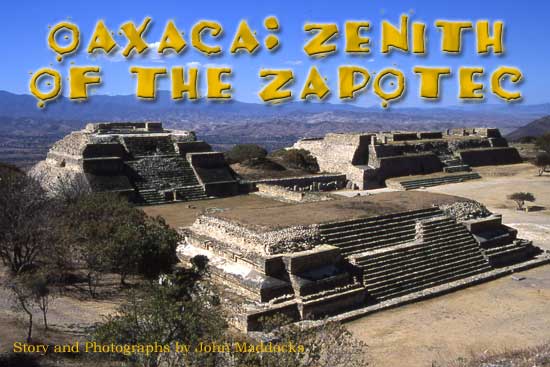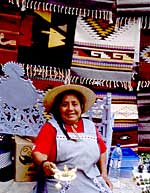|
|
Oaxaca: Zenith
of the Zapotec Many of Oaxaca's delightful colonial buildings were constructed in the 16th and 17th centuries. Central Oaxaca, with its cobblestone streets and ornate facades, has a strong sense of history. At its heart lies the zocalo, a large shady pedestrian central plaza that is the focus of much of the city's traditional activity. A raised sandstone area in the in the centre of the zocalo features an ornate 19th century bandstand. This space is often used for art and photographic exhibitions. And there are numerous cafes and restaurants in the arcades on the perimeter of the square that are ideal venues for having a drink while watching the colourful life of the plaza. Much of Oaxaca's status as a cultural centre derives from its excellent museums, galleries and churches. The Iglesia de Santo Domingo, situated 500 metres north of the zocalo, is the city's most beautiful church. Completed in 1666, its striking facade is matched by an opulent baroque interior with extensive gilded plasterwork. Outside the city, on a hilltop a few kilometers from Oaxaca, are the impressive ruins at Monte Albán (White Mountain), the ancient Zapotec capital. Founded about 500 BC, the extensive site has enormous plaza, elevated platforms with wide staircases and a series of tombs. Fascinating carvings of dancers at the foot of one of the Monte Albán buildings were made between 500 and 200 BC, and nearby hieroglyphs represent the earliest writings in Mexico. Treasure found in one of the tombs is regarded as among the most significant in the Americas, and is on display in the Museum of Oaxacan Cultures. Oaxaca is also surrounded by the Valles Centrales (Central Valleys) that contain Zapotec villages specialising in a number of crafts, including weaving, carpet making and pottery. Many of the villages also have colourful local markets and ancient ruins nearby. All of the villages
in the Valles Centrales can be visited on day trips. We decided
to head to the Friday market at Ocotlan, 32 kilometres from Oaxaca,
which has apparently been running every week for centuries. Teotitlan is famous for its mezcal, the potent drink made from the sap of the maguey plant. A rather charming and effective sales approach at the Teotitlan market is to offer samples at the numerous mezcal stalls. As there are many varieties featuring fruit and other flavours, mezcal tasting can be an involved but rewarding process. Mitla was a pre-Hispanic Zapotec religious site, and the ruins there have distinctive ornate stonework in geometric patterns. There are also two underground tombs, one of which contains a column known as the 'column of life'. "If you put your arms around the column the distance between your fingertips indicates how long you will live," our guide told us cheerfully. Buoyed by my mezcal sampling at Teotitlan, I crawled into the tomb and embraced the column of life, only to find that my hands overlapped! "I usually advise tall
people like you with long arms not to try out the column of life,"
the guide said with an apologetic smile. "So I hope you're not
superstitious."
More stories by this writer: Mui Ne: Dune With a View
|
||||||


 The
enchanting city of Oaxaca, 440 kilometres south of Mexico City, is situated
in the middle of spectacular rocky deserts of towering cacti. Encircled
by protective mountains, this sophisticated city boasts some of the
finest Spanish colonial architecture in Mexico. Oaxaca, which is one
of the country’s major arts and crafts centres, also has numerous
pre-Hispanic ruins nearby and a large Zapotec and Mixtec indigenous
population.
The
enchanting city of Oaxaca, 440 kilometres south of Mexico City, is situated
in the middle of spectacular rocky deserts of towering cacti. Encircled
by protective mountains, this sophisticated city boasts some of the
finest Spanish colonial architecture in Mexico. Oaxaca, which is one
of the country’s major arts and crafts centres, also has numerous
pre-Hispanic ruins nearby and a large Zapotec and Mixtec indigenous
population. Here
there are stalls selling handcrafts, including carpets, pottery and
jewellery, made by the local Zapotec and Mixtec people. Shoeshine boys
ply their trade while hawkers clutching dozens of inflated balloons
entice the local children. There always seems to be a procession or
public meeting taking place, and a band or buskers playing nearby.
Here
there are stalls selling handcrafts, including carpets, pottery and
jewellery, made by the local Zapotec and Mixtec people. Shoeshine boys
ply their trade while hawkers clutching dozens of inflated balloons
entice the local children. There always seems to be a procession or
public meeting taking place, and a band or buskers playing nearby.  The
restaurants also serve Oaxacan specialities including dishes featuring
quesillo, a mild stringy cheese, and chicken with mole
negro, a dark sauce made from spicy ingredients and chocolate.
My favourite dish was the leaf pad of the prickly pear cactus cooked
and served with stringy cheese. Vendors in the plaza also sell fried
grasshoppers, which are eaten with a dash of lemon or lime.
The
restaurants also serve Oaxacan specialities including dishes featuring
quesillo, a mild stringy cheese, and chicken with mole
negro, a dark sauce made from spicy ingredients and chocolate.
My favourite dish was the leaf pad of the prickly pear cactus cooked
and served with stringy cheese. Vendors in the plaza also sell fried
grasshoppers, which are eaten with a dash of lemon or lime.  Adjoining
the church is the outstanding Museum of Oaxacan Cultures (Museo
de las Culturas de Oaxaca). You can spend hours in this huge museum,
which was formerly a Dominican monastery, looking at exhibits and artefacts
dating from pre-Hispanic to recent times.
Adjoining
the church is the outstanding Museum of Oaxacan Cultures (Museo
de las Culturas de Oaxaca). You can spend hours in this huge museum,
which was formerly a Dominican monastery, looking at exhibits and artefacts
dating from pre-Hispanic to recent times. Story
and photographs by John Maddocks
Story
and photographs by John Maddocks